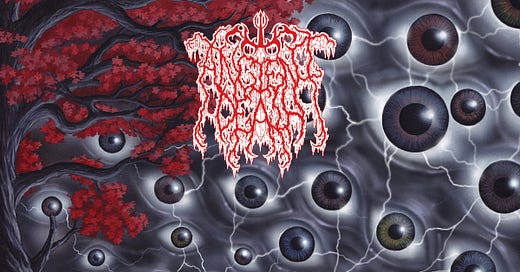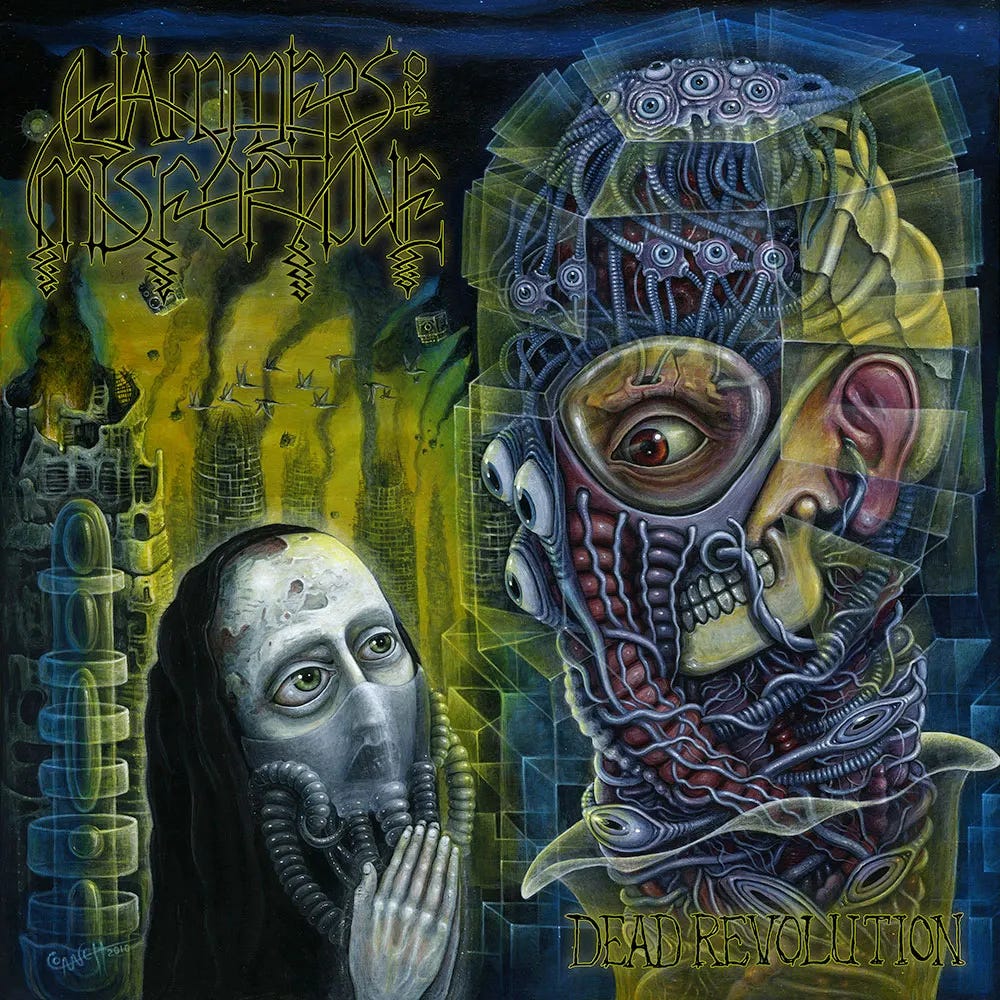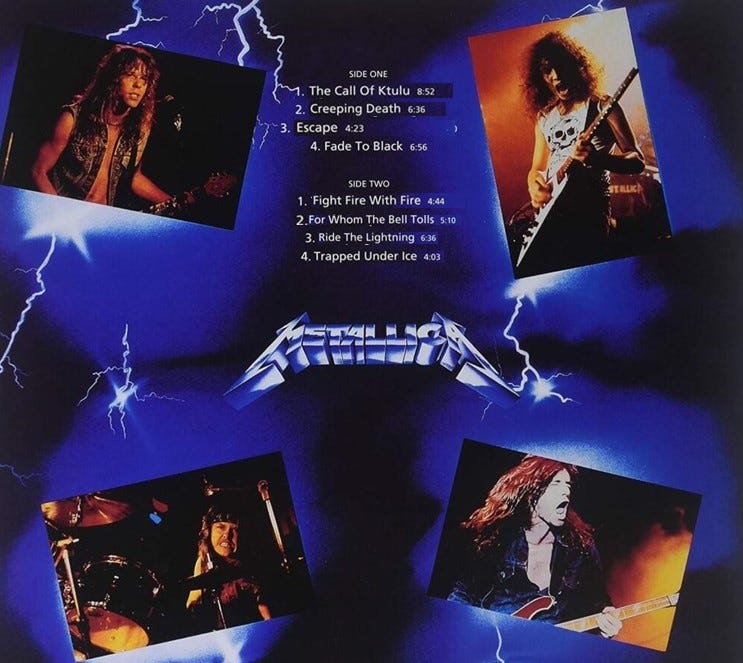Today I am trying to bait and switch you with this post that is a review of the debut album from the Massachusetts band Ancient Death, except that it is also a dissection of a seemingly insignificant error.
What I really like about the album is that it sounds like every player is fully invested at all times. Part of that is a result of the production, which has a sort of chewy immediacy that puts the real sounds of real humans touching real instruments right up close to the eardrums. But another part of it is “simply” (in scare quotes because it’s actually not simple at all) that the compositions allow each instrument to do something interesting and important, even when they’re not playing the ostensible lead. Right away on the album-opening title track, for example: it opens with both guitars playing eight bars of a thrashy death riff in unison, but then for the next eight bars, the left stereo guitar splits off into tremoloing arpeggios while the right-channel guitar continues on with its scrappy spider-riffing. At the 2:15 mark, the band drops into a calm midsection, but even here in the quiet, the bass and both guitars go through self-contained moves that create a three-part polyphony.
That’s a really micro-level look at Ancient Death, so in the interest of stepping back a bit, I’ll say that Ego Dissolution is one of those great death metal albums that feels sorta like, well… regular-ass death metal, except that it also has a whole lot more going on. And both those experiences play across the brain simultaneously as the album flies by, which I think is a tribute to the way that Ancient Death has internalized many of the moves that made some of death metal’s earliest technical innovators stand out. This means that they channel a bit of Human/ITP-era Death, a touch of Cynic, and a fairly heaping serving of Atheist (particularly if you can envision an imaginary middle point between Atheist’s first two albums). In keeping with those halcyon times, Ego Dissolution also deserves to be praised to the rafters for doing its business in a beautifully tidy 35 minutes.
Apart from that, though, the way the band integrates different vocal styles from both Jerry Witunsky and Jasmine Alexander sometimes makes Ego Dissolution feel like a version of Atheist steeped in both Circle Takes the Square’s As the Roots Undo and Burst’s Origo. Alexander’s ever-present and beautifully active bass is one of Ancient Death’s best selling points, and there are enough guitar pyrotechnics to hopefully keep even the most rabid death metal fiends from bolting for the hills when I tell you that I hear echoes of screamo and noise rock (particularly on more meditative tunes like “Breathe - Transcend (Into the Glowing Streams of Forever)” and “Echoing Chambers Within the Dismal Mind”), and that elsewhere you could almost convince me we’re hearing something like Shellac and Bosse de Nage interpreting Meshuggah’s “The Last Vigil.” Great, right? and/or also shut up.
[Ego Dissolution will be released tomorrow, 4/18, on Profound Lore.]
And now, for a stupid story. When I got the promo for Ego Dissolution, I downloaded it to my phone. My first impression of the album was really strong, and it kept sinking in more each time I listened. I probably made it through four or five different times before I realized that I had inadvertently been listening to the promo out of sequence. When the album loaded up on my phone, it defaulted to playing in alphabetical order. No big deal, right? So I played around with the metadata and got things sorted into their correct intended order. And then… I didn’t really like it. Major bummer.
But it got me wondering: just what in the hell is it that made the album suddenly alien to me? There are twin concepts from psychology - the primacy and recency effects - that suggest the earliest and most recent items in a sequence are the easiest for us to remember. Certainly that could have played a part, but I feel like that still doesn’t explain the strangeness, because truly, when I started listening to the album in its intended sequence, it felt wrong. In alphabetical order, the album kicks off with “Breaking the Barriers of Hope,” which wastes exactly zero seconds in getting down to the business of tearing shit up. Now the album was trying to convince me that its real opening move wasn’t this at all? What the absolute hell.
In my original (fuckup) version, that colossal whirlwind of an opener downshifted immediately into the sedate, pensive “Breathe - Transcend,” which felt like a bold sidestep of a one-two punch. In that sequence, when the 4:03 mark hits in “Breathe - Transcend,” I had this feeling that every player was digging into their instrumental attack so hard that it was as if they were using their instruments physically, attempting to dredge up tectonic plates and reorder the known world. And in my alpha/wrong order, the brief instrumental “Discarnate” as the third track was a baffling move. Now, in correct playing order, “Discarnate” falls second to last, right before the lengthy closing tune. It makes perfect sense, but in a way, it also turns the piece from a boldly off-putting statement into something superfluous.
My point here is not to convince you that you should listen to the album in any other way than what Ancient Death intended. Now that enough time has passed since I put the songs in correct order, I’m back to loving the album. But it took real effort! In fact, it really felt like I had to unlearn my first experiences with the album before I could engage with it on its own terms. Pretty fucking weird, considering that in most functional respects, it was exactly the same album both times - same songs, same notes, same players, same exact duration of time. So I guess my point is that when you take the time to listen to an album, you’re not only learning the notes or the songs or even just the transitions from each song to the next; there’s a thingness about an album that is somehow irreducible to the bits that make it up.
And experiences like this really stick. When Hammers Of Misfortune’s Dead Revolution came out, I listened to and fell in love with the album first on the basis of an advance digital promo. And when I reviewed it for Last Rites, I spent a decent amount of time in that review talking about how it worked so well based on where certain songs fell. When the album was finally released I bought the LP, eagerly tossed it on the turntable, and then… I didn’t really like it. The gosh darn rascals intentionally flipped the track order between the CD/digital versions and the LP version, and friend, let me tell you that I am almost still upset about it. (It has been almost ten years.) Now, I’m fairly certain the reason for the rearrangement is that the first four tunes on the CD/digital version would be too long for side A, but honestly the disorientation of learning the album so well in the course of reviewing it, only to find that now it also existed as this other thing caused a non-trivial amount of existential(ish) angst about whether there even WAS such a thing as a “real” version of Dead Revolution.
If you want to put the simplest possible explanation on this phenomenon, you could argue that when our brains learn a thing in order (say, song 1 into song 2 into song 3), they come to expect that order as a constituent part of each of the individual songs. It’s familiarity, basically. Think about the word disorder. In its Latin roots, it means simply “not ordered” or “not in order.” But in common usage, what does disorder mean? It means confusion, chaos, havoc. It means (here’s another great etymology) pandemonium.
You’ve probably heard about people with synesthesia, where their experience with one sense (e.g., sound) will be inextricably linked with some other sense or perception (e.g., color). One type of synesthesia is called spatial-sequence synesthesia, and it occurs for people who experience certain patterns or sequences (for example, the letters of the alphabet or the months of the calendar year) in a visual or diagrammatic sense. These people can draw you a picture of where the days of the week or a sequence of years or numbers are in space, or how they are arranged relative to their own bodies. I don’t think I fall into this category, but something about this concept makes sense to me when I think about how incorrect these albums felt when I suddenly had to hear them in a different order. It also makes me wonder if, in the process of absorbing music, we somehow translate it or situate it relative to our bodies. Whether we craft a shelter for it, or travel next to it, or see ourselves inside it, ringed by its centripetal force.
To test this out a little more, I created an alternate playlist of Metallica’s Ride the Lightning by ordering the tracks in alphabetical order. And perhaps unsurprisingly… I didn’t really like it. But my goodness, it’s a fascinating (if almost nails-on-a-chalkboard impossible) exercise.
To be honest, I can see a world where Ride the Lightning actually opens with “The Call of Ktulu.” The ominous slow build and delicate acoustics obviously set the tone one hell of a lot differently than the exhilarating dread of “Fight Fire With Fire,” but still. And yes, “Creeping Death” will basically go gangbusters no matter where you put it. But yeesh, “Creeping Death” into “Escape” is a tough sell, and even though “Fade to Black” closes out side A for real as well as alphabetically, it feels somehow less well-earned this way. To give credit where due, because Apple Music has a short crossfade built in, the transition from the extended outro of “Fade to Black” into the acoustic guitar intro of “Fight Fire” is actually really nice. However, not having the explosion sound effect at the end of “Fight Fire” burst immediately into the nervy twang of the title track is some real uncanny valley shit. The real kicker is, if you arrange things this way so that the album closes with “For Whom the Bell Tolls” into “Ride the Lightning” into “Trapped Under Ice,” it sort of progresses from darkest/most complex songs into (relatively) lighter fare, giving the reconfigured album the flavor of a band that staked it all upfront on the deepest chasms only to ride into the sunset on a burnt-orange parasailer.
Maybe it’s impossible to do this with Metallica or Black Sabbath or Iron Maiden or any other band whose recorded history has become the bedrock DNA of the entire damn genre. Maybe the only thing this illustrates is that counterfactuals are difficult. Once a thing exists, it gets harder to imagine that it could have existed otherwise. Ancient Death is a good band and Ego Dissolution is a good album, no matter how you arrange it. I might even traipse out onto the farthest of limbs to say that Ride the Lightning is also a good album, y’all. I still feel fascinated (and a bit frightened) at the thought that a work of art has some mysterious quotient that goes beyond the strictly additive. Mathematically speaking, (a + b + c) = (a + c + b) = (c + a + b) = all other configurations besides. So in what does that thingness inhere? What else is out there, just beyond our parentheses, inscribing a stone with words that can’t be read?






